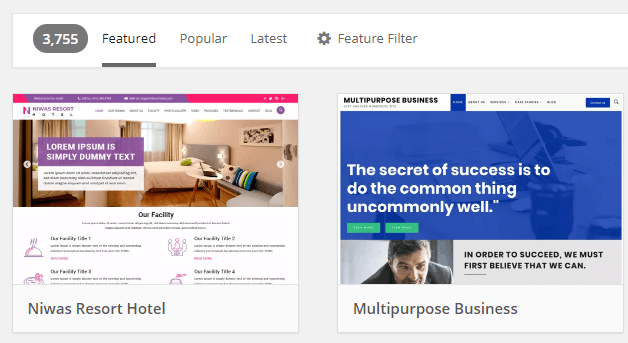How To Connect Wordpress Blog To Wordpress Site
How to Add a Blog to an Existing Site
Posted in WordPress by Samantha Rodriguez
Last updated on December 4th, 2018

A lot of businesses find that running a blog is a great way to boost traffic to their websites. That traffic, in turn, is something you can turn into additional business. The problem is that setting up a blog for an already existing site can take a bit of work.
If you use WordPress, however, you're in luck. With this Content Management System (CMS), you can easily set up a new website to act as your blog, and link it to your main site. You can even do this using a subdomain or subdirectory, so you can still use your primary domain.
In this article, we'll teach you how to add a blog to your existing website. We'll go over two potential methods, and explain all of the steps involved. Let's get your blog up and running!
Choose a Subdirectory or Subdomain
The best way to add a blog to your existing WordPress website is to create a new site altogether. You can do this while still using the same domain as your main site, by installing WordPress in a subdirectory or a subdomain.
Here are two examples of what that might look like:
- Subdomain: blog.yourwebsite.com
- Subdirectory: yourwebsite.com/blog
From a functional standpoint, both approaches work just the same. There's some debate about what the best option is, but as far as Google is concerned, it treats subdomains and subdirectories equally.
If you don't have a personal preference, we suggest that you use a subdomain, as it's the most efficient solution. We'll show you how to use both approaches, however, so you can choose for yourself.
Installing WordPress in a Subdomain
First up, let's look at how to set up your blog using a subdomain. This is the approach we recommend here at WP Engine, and it only takes three steps.
Step 1: Set Up a Subdomain
How you approach this process will depend on which web host you use. For example, a lot of hosting providers use cPanel, which includes an option to set up subdomains with just a few clicks.
If you're a WP Engine user, you can navigate to your User Portal and choose the Add Domain option. Then, you just need to choose the domain you want to use, and pick a name for your subdomain.
After your subdomain is ready, you can install WordPress through your user panel. Simply go to the Installs tab in your dashboard, and choose the Add Install option. Then, you'll be able to set up a new WordPress installation on your subdomain.
Keep in mind that if you plan on running more than two WordPress sites, it might be in your best interests to use a Multisite setup. With multisite, you can easily add more installations using their own subdomains or subdirectories, all from your WordPress dashboard.
Step 2: Choose a Theme to Match Your Existing Site
Whichever approach you choose to create your blog, you'll also need to set up a theme for it. Ideally, this theme will share a similar style to your main website. That way, people won't notice that they're navigating through two different sites.
You're free to pick whichever theme you want, of course. If you're not sure where to start, the WordPress Theme Directory is always a great resource:

Within, you'll find thousands of options. We recommend that you stick to those with positive reviews and recent updates. You'll also want to preview any theme you're interested in, to make sure it's mobile-friendly.
Along with choosing a matching theme, it's also best to use the same fonts throughout your main website and blog (for consistency's sake). To learn how to do that, check out our full guide on how to change your WordPress blog fonts.
Step 3: Add Menu Links
To further maintain the illusion that your primary website and blog are two parts of a whole, they'll need to share identical menus. That process involves two steps:
- Adding a link to your blog to your website's navigation menu.
- Duplicating your main site's menu on your blog itself.
Adding menu items to WordPress is quite simple. If you're not familiar with the process, check out this guide on how to create WordPress menus.
Installing WordPress in a Subdirectory
Before we wrap up, let's look at the other way to set up your WordPress blog. Keep in mind that WP Engine does not support the use of subdirectories for WordPress installations. This means that if you're a WP Engine user, you'll need to stick with subdomains.
Step 1: Install WordPress in Your Blog Subdirectory (And Configure It)
The process of creating a subdirectory will vary depending on your host. However, in most cases, you should be able to find an option for it within your control panel.
After that, all you have to do is choose the domain you want to use, and pick a name for your subdirectory. Then, it's time to install WordPress on it, which you should also be able to do from your user panel.
Just as with the previous approach, you can also use multisite to add WordPress websites using subdirectories, all without leaving your dashboard. When your site is up, remember to update your permalink structure right away, so that your blog's URLs look nice.
Step 2: Choose a Theme
As we explained before, your WordPress blog's theme should match the style of your main website. Otherwise, people will be confused when they make the jump from one to the other.
To a visitor, everything should appear to be a single website, from layout to fonts. We already covered this process in depth earlier, so feel free to refer back to that section for more details.
Step 3: Create Your Menu
The main way visitors will move through your website is by using its navigation menu. Both your primary website and blog will need their own menus. If those menus are identical, visitors shouldn't notice that they're moving from site to site.
To achieve this, you'll need to add a link to your WordPress blog to your main website's menu. Once that's done, you'll want to copy that entire menu, and add it to your WordPress blog.
If you choose a theme that matches your site's style, once you add your new menu your blog should be a perfect match.
Download the WordPress Pre-Launch Checklist
Adding a WordPress blog to your website can be a smart decision for your business. With a regularly-updated blog, you can position your company as an authority, and drive more traffic over to your main site.
Within our knowledge base, you'll find a lot of content you can use to learn how to launch a WordPress blog, using either subdomain or a subdirectory. Plus, we'll also teach you how to edit every aspect of your blog, from its fonts and colors to larger design concerns.
If you sign up for one of our plans, you'll get access to all of that, as well as excellent performance and support. Check them out today!
How To Connect Wordpress Blog To Wordpress Site
Source: https://wpengine.com/resources/add-blog-to-site/
Posted by: madrugahoner1988.blogspot.com

0 Response to "How To Connect Wordpress Blog To Wordpress Site"
Post a Comment